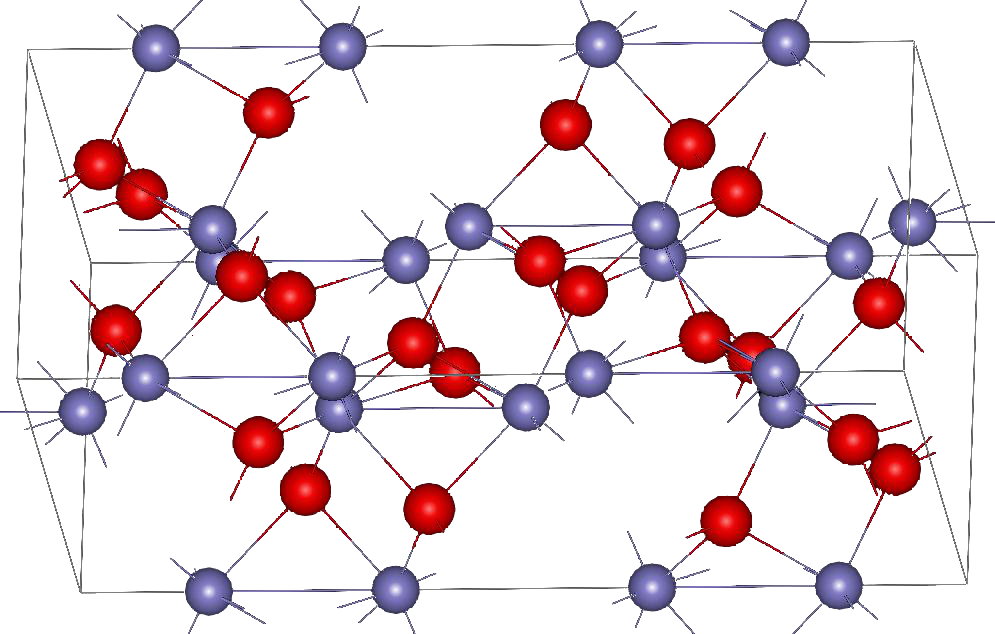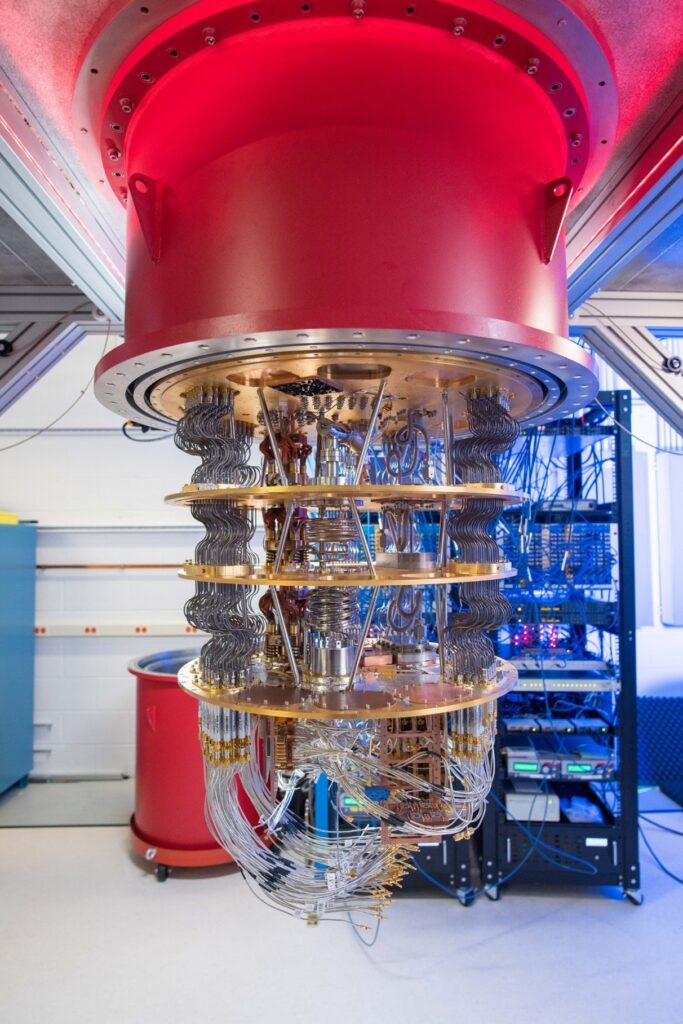Crystals have always triggered the curiosity and creativity of humans throughout history.
Macroscopically, crystals can be recognized by their geometrical shapes, with unusually flat surfaces like diamonds and rubies. Humans have often attributed (sometimes unjustifiably) value and even magical properties to many of these peculiar materials. Now, inspired by them, physicists are exploring new possibilities in the realm of quantum mechanics.

Hematite is a crystal made of iron oxide. Some people believe it provides protection.
The characteristic shapes of crystals derive from their microscopic structure which defines them.
The constituents (i.e., molecules, atoms, or ions) of crystalline materials are arranged in a highly organized way, forming a periodic arrangement of unit cells. A unit cell is like an imaginary box containing one or more constituents in a specific spatial arrangement. If we stack these unit cells in three-dimensional space so that the constituents sit at the vertices of a crystal lattice, we have a crystal.
Crystal lattice: “In geometry and crystallography, a Bravais lattice is an infinite array of discrete points generated by a set of discrete translation operations. […] The Bravais lattice concept is used to formally define a crystalline arrangement and its (finite) frontiers. A crystal is made up of one or more atoms, called the basis or motif, at each lattice point. The basis may consist of atoms, molecules, or polymer strings of solid matter, and the lattice provides the locations of the basis.” Wikipedia..

Molecular structure of the unit cell of a hematite crystal. Atoms of oxygen are in red and atoms of iron are in blue. Image Source
In 2012, inspired by the repeating structures of crystals that are distributed in space, the Nobel Prize-winning physicist Dr. Frank Wilczek proposed the possibility of an analogous type of material. Instead of repeating structures in space, the new material would be a quantum system with periodicity in time. It would switch between quantum states in regular time intervals indefinitely and without consuming energy. Dr. Wilczek named this theoretical material a “time crystal.” However, its existence was merely a theoretical possibility, with no proven existence in the real world. But the concept was so enticing that scientists raced to create time crystals and, after almost ten years, they finally made it.
One of the peculiarities of crystalline materials is that they spontaneously break the prediction of the theorem of space-translation symmetry.
This theorem derives from the momentum conservation law. Translation symmetry means that shifting an object does not change what it is. But even though the constituents of crystals are governed by the same laws of physics everywhere in space, they show periodic spatial variations, implying that this is their state of minimum-energy equilibrium.
The breaking of space-translation symmetry by conventional crystals is the key to understanding the concept of time crystals.
The constituents of time crystals move in a regular, repeating cycle without burning any energy. For this to be possible, they must have more than one stable quantum state. Under the right circumstances, the material alternates between these states with remarkably regular periodicity. Thus, time crystals are the only known stable objects that are not the same throughout time. They break time-translation symmetry.
Not surprisingly, creating a time crystal has proven to be extremely difficult.
There are two basic criteria for determining whether a system is a true time crystal: it must resist fluctuations, and the energy that drives it must not cause it to heat up. To meet the second condition, scientists had to explore strategies that applied knowledge of many-body problems so that the interactions between particles within the system would lead to thermal stability.
“The many-body problem is a general name for a vast category of physical problems pertaining to the properties of microscopic systems made of many interacting particles. Microscopic here implies that quantum mechanics has to be used to provide an accurate description of the system. […] In such a quantum system, the repeated interactions between particles create quantum correlations, or entanglement.” Wikipedia.
In 2005, physicists at Princeton and Columbia Universities showed that a chain of quantum particles can get stuck in a fixed state under certain circumstances.
In a chain of quantum particles, each particle has a spin – up, down, or some probability of both – that naturally fluctuates and tends to align. Random interference between them can cause the particles to get stuck in a particular configuration, unable to settle into thermal equilibrium. In other words, the particles localize. And if you flip all the spins in that system, you get another stable localized state. These are the states between which time crystals switch.
The theoretical approach to producing the features of time crystals is relatively simple, although it has only recently been possible to actually create them.
Researchers must introduce a certain amount of disorder into a many-body system so that the interactions of the particles destructively interfere with each other, making them localize. The disorder maintains the system’s stability and prevents it from heating up. This effect is a remarkable achievement in itself, because it means that the system effectively circumvents the second law of thermodynamics – the law that states that disorder always increases.
The creation of time crystals expanded the definition of the phases of matter.
All previously known phases (e.g., solid, liquid, gas) are in thermal equilibrium – the state of lowest energy allowed by the environment, with properties that do not change with time. Time crystals are the first out-of-equilibrium phase that exhibits order and stability while excited and constantly changing.
In 2015, Dr. Xiao Mi, a researcher at Google, authored a preprint assessing how a many-body localized system responds to periodic stimuli with a laser. Using simulations, they concluded that, when stimulated, a localized chain of spins switches between two stable many-body localized states without absorbing net energy. This is the predicted behavior of time crystals.
In the following year, a group led by Dr. Chetan Nayak, a researcher at Microsoft, used this discovery to exemplify their proposition of what they called Floquet time crystals. Floquet time crystals are systems that exhibit the same behavior as time crystals, except that they only do so while being periodically driven by an external energy source. This difference circumvents the requirement of thermal equilibrium, given that it is a many-body localized system and, therefore, its components are unable to align, as they would otherwise tend to.
A collaboration between Dr. Nayak’s team and Dr. Christopher Monroe, professor at the University of Maryland, got close to creating a time crystal. They used electromagnetic fields to trap ions in a many-body system, forming what they called a “prethermal” time crystal. The cyclical variations observed in this system are practically indistinguishable from the variations expected of a true time crystal. However, unlike time crystals, if the experiment ran for long enough it would gradually reach equilibrium and break the cyclical behavior.
In a separate experiment, researchers at Google collaborated with researchers at the Max Planck Institute for the Physics of Complex Systems and Stanford and Princeton universities to create a Floquet time crystal using Google’s quantum computer. Quantum computers consist of controllable quantum particles called qubits that can individually maintain two possible energy states. The states of the qubits can be programmed to represent spins. This allows researchers to fabricate and control a group of qubits to form a many-body system.
“Quantum computing is a type of computation that harnesses the collective properties of quantum states, such as superposition, interference, and entanglement, to perform calculations. The devices that perform quantum computations are known as quantum computers.” Wikipedia.
The team created a time crystal using a group of 20 qubits and set arbitrary initial spin configurations, hoping to observe the new phase of matter. They achieved many-body localization of the qubits by randomly tuning the strength of the interactions, which led to destructive interference between the qubits. After tens of thousands of runs, they could observe that the system switched between many-body localized states. And as expected from a real time crystal, the spins neither absorbed nor dissipated net energy from the laser.

The device used to maintain the required low-temperatures of operation in Google’s quantum computer.
To make matters even more exciting, another group of researchers also announced the creation of a time crystal in 2021, this time in a diamond. Researchers at QuTech in the Netherlands, the University of California, and the firm Element Six built a Floquet time crystal using the nuclear spins of atoms located near a defect in a diamond’s crystal lattice.
Even though the system had limited durability, it showed remarkable robustness. The team used optical techniques to control and detect the spins in the atoms by setting the initial configuration and switching between states using radiofrequency pulses. The system successfully cycled through stable states, though it could only maintain it for 800 cycles – about eight seconds. But regardless of the system’s initial state, it formed a stable cycle, meaning that it was indeed being stabilized by disorder as a time crystal would.

Surface of a diamond, showing the flat surfaces formed by the structure of the crystal lattice.
These new developments in the race for time crystals are undeniably interesting, but their significance for the real world may require deeper consideration.
Time crystals carry the potential to contribute to a more complete understanding of the universe in areas such as thermodynamics and general relativity. Just like the first discovery of a black swan causes us to reconsider the assumption that all swans are white, an out-of-equilibrium phase of matter that spontaneously breaks time-translation symmetry will cause us to reevaluate many things we thought we knew.
Although we may never find practical applications for time crystals, their potential conceptual importance is already immeasurable.
Nature probably never creates time crystals. They are a product of physicists’ imaginations, made possible by the laws of quantum mechanics. Now that time crystals have crossed the threshold from theory to reality, scientists are wondering how many other phases might be possible. This is a first step from merely studying what is real to imagining what could be and then making it a reality.



